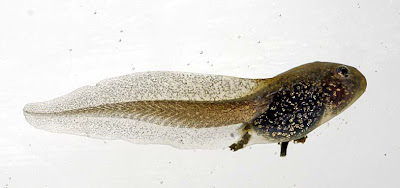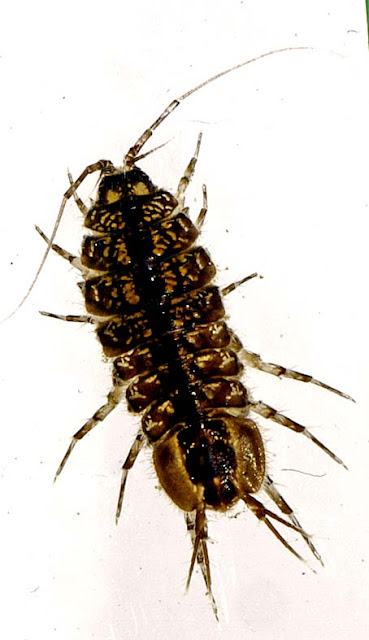Showing posts with label Asellus aquaticus. Show all posts
Showing posts with label Asellus aquaticus. Show all posts
Friday, June 28, 2013
Pond Life
A quick sampling of the tadpoles in our garden pond showed that many of them were still some way off developing limbs, which I guess is a sign of the late spring - the frogs spawned very late this year. (Double-click for a larger image).
This tadpole is a sharing the trough that I photographed it in with a flatworm.
A water log-louse Asellus aquaticus. There are vast numbers of these scavengers down at the bottom of the pond, where there's thick layer of decaying leaves.
Underside of a water hog-louse. These crustaceans are isopods - all their legs are more or less the same length. For more isopods, click here and here.
Possibly the least lovable animal in the pond - a leech. I suspect that these parasitize the pond snails. The dark patterning is its digestive system, visible through the body wall.
Labels:
Amphibians,
Asellus aquaticus,
crustaceans,
flatworm,
Frog,
isopods,
leech,
tadpole,
water hog-louse,
Wildlife garden
Monday, April 30, 2012
Water Hog-louse
Our small garden pond (the same one that's home to the newts mentioned in a previous post) is also home to a thriving water hog-louse (aka water slater) Asellus aquaticus population - and this is their breeding season. This is a mating pair and eventually the female will carry her fertilised eggs around with her under the front of her flattened body. These are crustaceans which exhibit a considerable level of maternal care of their offspring and when the eggs have hatched the female will continue to carry her young under her body, between the front two pairs of legs until they're old enough to fend for themselves. Water hog-lice aren't too fussy about water quality and so will thrive in small aquaria, where it's easy to watch their reproductive cycle.
The brown pigmentation of their exoskeleton takes time to develop and in the youngsters it's transparent, which makes it easy to watch the workings of their internal organs under a microscope. This one is a juvenile that is only just beginning to develop the vestiges of pigmentation .....
..... and this one is a little further along the road to adulthood.
Asellus is an isopod crustacean, meaning that all of its legs are of similar length, unlike the amphipods that have a combination of long and short legs.
Labels:
Asellus aquaticus,
crustaceans,
isopods,
water hog-louse,
water slater
Subscribe to:
Posts (Atom)































